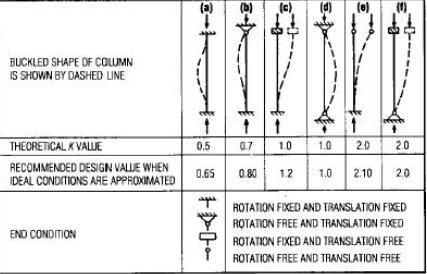The AISC specification for allowable-stress design (ASD) for buildings provides two formulas for computing allowable compressive stress Fa, ksi (MPa), for main members. The formula to use depends on the relationship of the largest effective slenderness ratio Kl/r of the cross section of any unbraced segment to a factor C c defined by the following equation and table below:
Where
E=modulus of elasticity of steel =29,000 ksi ( 128.99 GPa )
Fy=Yield stress of steel, ksi (MPa)
When Kl/r is less than C c ,
Fy=36, Cc =126.1
Fy=50, Cc =107
The effective-length factor K, equal to the ratio of effective-column length to actual unbraced length, may be greater or less than 1.0. Theoretical K values for six idealized conditions, in which joint rotation and translation are either fully realized or nonexistent, are tabulated in Figure below

If you have a query, you can ask a question here.



the E value of 128Gpa is wrong, should be 193-200 Gpa
Hi good afternoon sir/madam or brother. i have two questions…. 1. is this formula depending on buckling…
2. i’ve considered a factor of safety of 5 for my project…for the material i’ve considered 275 Mpa is the yield stress. so the allowable stress is 55 Mpa…but in the formula it self… they considered a factor of safety…can is use the value 55Mpa for yield stress. please let me know..